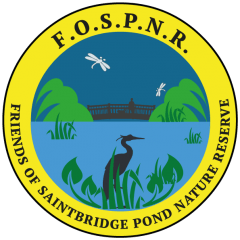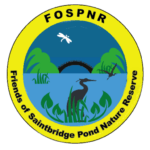August was a very good month for birds at Saintbridge Pond Local Nature Reserve. The highlights included the Little Egret which was seen on the 6th of August, either perched in the trees on the large island or seen fishing for sticklebacks in the shallow waters of the pond margins. The pond also played host to a single Kingfisher on the 6th and 23rd with 2 seen on the 20th and 30th of the month respectively. This bird is often located by its whistling call or seen flying low over the water,
The site had a pair of nesting Sparrowhawks this summer and they could be heard in the trees North of the main island on the 6th. A female was observed flying to the large island and settled in the willow trees on the 23rd. Nesting season over for another year as the young birds in the nest can no longer be heard calling. A local man claimed to have witnessed the young disperse from the nest site.
Mallard numbers seem to be quite large with approximately 25 seen on the 6th and 20th, 40 on the 23rd and a peak count of 91 on the 30th of the month. These birds are well fed with bird seeds from local residents. Lesser black-backed gulls and Herring Gulls probably responsible for predation of chicks as these ducks failed to breed successfully on site this year.
A Buzzard flew over the Allotments on the 20th of August.
1 or 2 Grey Wagtails were seen at the Sudbrook channel and large island section throughout the month. There were only 6-8 adult and 2 young Moorhens on site this month as some of the ponds population seemed to have flown elsewhere.
A Cormorant could be seen on the 30th and 31st of the month circling around the pond and seen fishing on the deeper waters of the pond.
At this time of year the songbirds do not sing very often and common garden birds can be difficult to locate due to the leaves on the trees but Long-tailed Tits, Wrens, Robins and Blue Tits were seen in small numbers.
Small numbers of Wood Pigeon, Carrion Crow and Magpies are always on site. Black-headed Gulls are returning to the pond, probably having nested on the South Coast with 25 birds seen on the 23rd.
>> DOWNLOAD | Bird Sightings at Saintbridge Pond
Please help us maintain the pond and surrounding area by making a donation to help fund the work we do as volunteers. You’ll be helping us with your donation, 100% of funds received go to the work we do in conservation.[paypal_donation_button]




 Please help us maintain the pond and surrounding area by making a donation to help fund the work we do as volunteers. You’ll be helping us with your donation, 100% of funds received go to the work we do in conservation.
Please help us maintain the pond and surrounding area by making a donation to help fund the work we do as volunteers. You’ll be helping us with your donation, 100% of funds received go to the work we do in conservation.


 Kingfishers are small unmistakable bright blue and orange birds of slow moving or still water. They fly rapidly, low over water, and hunt fish from riverside perches, occasionally hovering above the water’s surface. They are vulnerable to hard winters and habitat degradation through pollution or unsympathetic management of watercourses. Kingfishers are amber listed because of their unfavourable conservation status in Europe.
Kingfishers are small unmistakable bright blue and orange birds of slow moving or still water. They fly rapidly, low over water, and hunt fish from riverside perches, occasionally hovering above the water’s surface. They are vulnerable to hard winters and habitat degradation through pollution or unsympathetic management of watercourses. Kingfishers are amber listed because of their unfavourable conservation status in Europe. The little egret is a small white heron with attractive white plumes on crest, back and chest, black legs and bill and yellow feet. It first appeared in the UK in significant numbers in 1989 and first bred in Dorset in 1996. Its colonization followed naturally from a range expansion into western and northern France in previous decades. It is now at home on numerous south coast sites, both as a breeding species and as a winter visitor.
The little egret is a small white heron with attractive white plumes on crest, back and chest, black legs and bill and yellow feet. It first appeared in the UK in significant numbers in 1989 and first bred in Dorset in 1996. Its colonization followed naturally from a range expansion into western and northern France in previous decades. It is now at home on numerous south coast sites, both as a breeding species and as a winter visitor.



